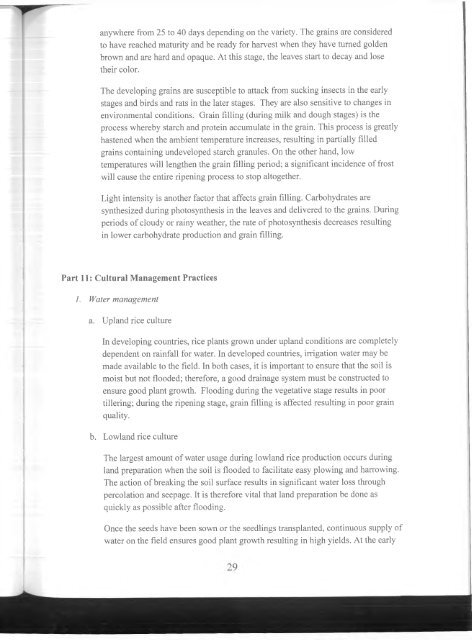Bradbrook - 2012 - Rice Farming complete with methods to increase ric
Bradbrook - 2012 - Rice Farming complete with methods to increase ric
Bradbrook - 2012 - Rice Farming complete with methods to increase ric
Create successful ePaper yourself
Turn your PDF publications into a flip-book with our unique Google optimized e-Paper software.
anywhere from 25 <strong>to</strong> 40 days depending on the variety. The grains are considered<br />
<strong>to</strong> have reached maturity and be ready for harvest when they have turned golden<br />
brown and are hard and opaque. At this stage, the leaves start <strong>to</strong> decay and lose<br />
their color.<br />
The developing grains are susceptible <strong>to</strong> attack from sucking insects in the early<br />
stages and birds and rats in the later stages. They are also sensitive <strong>to</strong> changes in<br />
environmental conditions. Grain filling (during milk and dough stages) is the<br />
process whereby starch and protein accumulate in the grain. This process is greatly<br />
hastened when the ambient temperature <strong>increase</strong>s, resulting in partially filled<br />
grains containing undeveloped starch granules. On the other hand, low<br />
temperatures will lengthen the grain filling period; a significant incidence of frost<br />
will cause the entire ripening process <strong>to</strong> s<strong>to</strong>p al<strong>to</strong>gether.<br />
Light intensity is another fac<strong>to</strong>r that affects grain filling. Carbohydrates are<br />
synthesized during pho<strong>to</strong>synthesis in the leaves and delivered <strong>to</strong> the grains. During<br />
periods of cloudy or rainy weather, the rate of pho<strong>to</strong>synthesis decreases resulting<br />
in lower carbohydrate production and grain filling.<br />
Part 11: Cultural Management Practices<br />
1. Water management<br />
a. Upland <strong>ric</strong>e culture<br />
In developing countries, <strong>ric</strong>e plants grown under upland conditions are <strong>complete</strong>ly<br />
dependent on rainfall for water. In developed countries, irrigation water may be<br />
made available <strong>to</strong> the field. In both cases, it is important <strong>to</strong> ensure that the soil is<br />
moist but not flooded; therefore, a good drainage system must be constructed <strong>to</strong><br />
ensure good plant growth. Flooding during the vegetative stage results in poor<br />
tillering; during the ripening stage, grain filling is affected resulting in poor grain<br />
quality.<br />
b. Lowland <strong>ric</strong>e culture<br />
The largest amount of water usage during lowland <strong>ric</strong>e production occurs during<br />
land preparation when the soil is flooded <strong>to</strong> facilitate easy plowing and harrowing.<br />
The action of breaking the soil surface results in significant water loss through<br />
percolation and seepage. It is therefore vital that land preparation be done as<br />
quickly as possible after flooding.<br />
Once the seeds have been sown or the seedlings transplanted, continuous supply of<br />
water on the field ensures good plant growth resulting in high yields. At the early

















